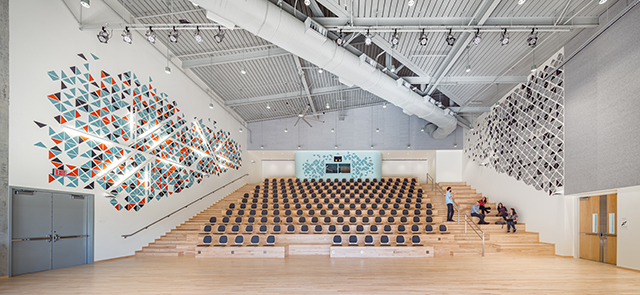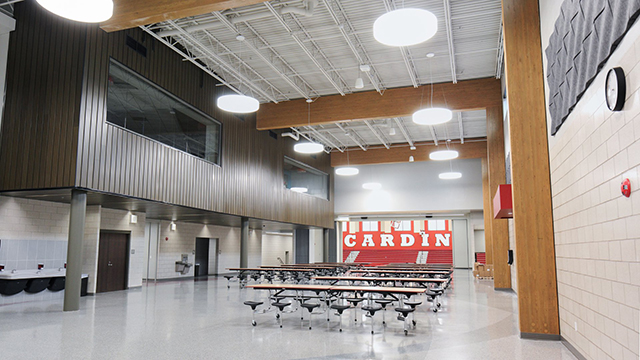Elevating Acoustic Design for Optimal Learning Environments
By Dana Pucillo and Michael DiTullo
When we think about acoustics in education, the spotlight often falls on auditoriums and libraries, yet an often-overlooked design consideration is the acoustics within classrooms and hallways. Imagine being a student seated in the back row of a classroom or lecture hall, struggling to concentrate while hearing sounds from outside noise and chatter within the classroom. The challenge of learning to focus, pay attention, and absorb new material becomes even more daunting in these distracting environments.
Poor acoustics within classrooms create challenging environments for children, who possess heightened sensitivity compared to adults or older peers. These conditions, characterized by noise and reverberation, significantly impact their ability to engage in tasks that require listening comprehension, as well as non-auditory functions like short-term memory, reading, and writing.
Today, as school systems demand more and more from their educational spaces, collaboration with facility managers becomes paramount, ensuring that the end user's needs are not only met but exceeded. While historically prevalent in higher education, the importance of acoustics is becoming more top of mind in K-12. This could shape the future of learning.
Dampening noises with acoustics will pave the way for enhanced concentration and focus — vital ingredients for effective learning at all grade levels. With cleaning and maintenance as a growing priority, there can no longer be carpet tiles, and often budgets do not allow for porous wood flooring. Acoustics applied to ceilings and walls help dampen echoes and other sounds, allowing teachers to be heard clearly. From kindergarten classrooms to university lecture halls, acoustics play a pivotal role in optimizing the learning environment.

Gladys Valley Marine Studies Building, Oregon State University
Photo courtesy of Josh Partee
Consider the Amount of Acoustics Needed and the Application
“It is so important to make sure there are enough acoustic products for the size of the space when you are early in the design process. One huge mistake I often see is people just not putting enough material in, and expecting a minimal amount of acoustic products to lift too heavy of an acoustic load,” said Michael DiTullo, Head of Product Innovation for Carnegie Acoustic Solutions.
It’s also important to consider the transformative power of huddle acoustic work areas, providing students with a sanctuary for focused collaboration away from the activity of shared spaces. Dividers offer opportunities for undisturbed concentration and honing of listening skills, essential elements of the learning process.
Choose Acoustics with High Marks for Sustainability
It’s important to look for acoustic products that also have high marks for sustainability. Many conventional acoustic materials contain harmful chemicals, which can adversely affect indoor air quality and student/faculty health. Sustainable acoustic products are also designed to be durable and long-lasting, reducing the need for frequent replacements.
“We always focus on high-performance materials and products that do little to no harm to the environment. The investment of acoustic products in commercial spaces promotes healthy environments for the end users in those spaces. The value is creating a space where people are comfortable, can focus, and do not want to escape from because there is too much chaos they are experiencing,” said Dana Pucillo, Vice President of Acoustic Solutions at Carnegie.

Spring Valley Elementary School
Photo courtesy of River Valley Architects
Embrace Your School or University Individuality
Acoustic design isn’t a written code meant to fit into every school or university. Different schools will have different needs. “Creating high-design education spaces is different from school to school and is dependent on the school's need. Remember to not get caught up in generic trends. No matter the school, it’s important to embrace the university’s individuality,” said DiTullo.
In a world where the clamor for bigger gyms and better dorms dominated the late '90s, today's educational landscape calls for a different approach — prioritizing spaces designed to nurture social interaction and communal growth. “Designers now can create aesthetic educational spaces that exert a hospitality feel, making the space suitable for mental and emotional relaxation. Sound absorption helps your brain feel like you have a warm blanket around you — no rough edges or cold surfaces. Through color and texture you can create impactful spaces that have warmth and feel inviting,” said Pucillo.
Acoustics are grounded in science, holding the key to unlocking the full potential of educational spaces. The evolution of educational spaces isn't about following trends but embracing the individuality of each institution. From K-12 design to university campuses, the focus must remain on creating environments that promote community, socialization, and ultimately, learning.
Just because it's an acoustic product, doesn’t mean it can’t add to the aesthetic. Great products can be high-performance, be made from sustainable materials, and have an iconic design. Creating impactful moments whether it be dynamic ceiling moments of colorful clouds at different levels or a dramatic use of multiple installations accentuating the height or length of a room — magnifying the scope of the space — makes one feel they are in an art installation. Imagine if students could feel this calm in a classroom every day. With the breadth of products on the market, there is no limit to design and inspiration.
“Today, it’s most important for schools to create spaces for people to learn how to socialize. We can encourage community through good design.” said DiTullo. Through thoughtful design and attention to acoustics, we can create educational environments where students and faculty thrive, not distracted by the noise, and fully immersed in the pursuit of knowledge.
Dana Pucillo is the Vice President of Acoustic Solutions at Carnegie, and Michael DiTullo is the Head of Product Innovation for Carnegie Acoustic Solutions.